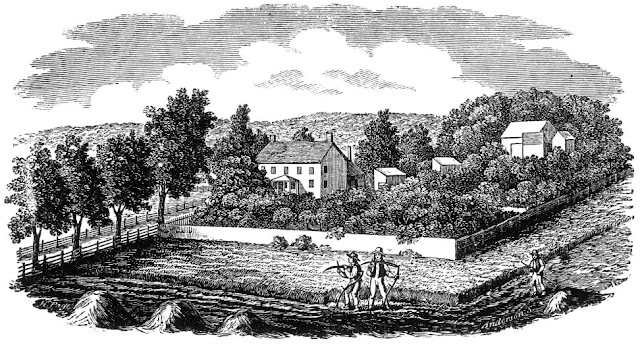M. (1) before 2 Jun 1734 in (probably) Staten Island, New York1,2
Wife: Maritje Van Pelt
M. (2) before 15 Jan 1739 in (probably) Staten Island, New York1
Wife: Margreitje Van Pelt
D. before 21 Oct 1791 in Somerset County, New Jersey3
During the American Revolution, some key military action took place in the middle of New Jersey. This is where the family of Abraham Van Tuyl lived, and they gave their full support to the American cause.
Abraham was born in about 1714 to Isaac Van Tuyl and Sarah Lakerman,1 and he was the third of six children. The Van Tuyl family was scattered over the northern part of Staten Island, and the house where Abraham’s family lived when he was a boy is still standing today. Isaac Van Tuyl was said to be in possession of it in 1719.
Abraham was only about 14-years-old when his father died in 1728; his inheritance was £30, which he likely didn’t receive until he came of age. When Abraham was about 20, he married Maritje Van Pelt, the daughter of Jan Van Pelt of Staten Island,1 and they had a child, Jan, who was baptized on June 2, 1734.2 Then she seems to have died, and Abraham married Margreitje Van Pelt by the end of 1738.1 They had eleven children, with the youngest born in about 1762.1
At some point, Abraham left Staten Island for the inland Dutch community of Somerset County, New Jersey. His home was in the region known as the Watchung Mountains, three ridges of about 500 feet in elevation that run parallel to the New Jersey coast. Abraham’s land was on the middle ridge — the Second Watchung Mountain; it was said to be “an isolated farm on the north side of the peak known as Mt. Horeb.”1
1766 map of Watchung Mountains showing Van Tuyl farms. (source: A Van Tuyl Chronicle)
Middlebrook Encampment flag. (source: Zeete, CC BY-SA 3.0 via Wikimedia Commons)
That camp was less than two miles from Abraham’s farm, and some of his married children lived even closer. His son Isaac and various sons-in law were “staunch patriots” who enlisted in the New Jersey Militia.1 Also everyone who lived in the area helped provision Washington’s army — a vital necessity of their military campaign.1
Abraham wrote his will on June 13, 1791,3 and he passed away by October 21st.3 He left his property to sons Abraham and Otto, and small amounts of money to other children, also making mention of a grandson Abraham, the son of his deceased oldest son, John. His wife Margreitje survived him, but it’s uncertain when she died.
Child by Maritje Van Pelt:
1. John Van Tuyl — B. before 2 Jun 1734, Staten Island, New York;2 D. before 16 Oct 1771, Sussex County, New Jersey;5 M. Marritje ______ (~1735-~1773), before 21 Mar 17566
Children by Margrietje Van Pelt:
1. Isaac Van Tuyl — B. 15 Jan 1739, Staten Island, New York;7 D. 3 Feb 1803, Bernards Township, New Jersey;7 M. Mary McCarter (1741-1797), 14 Nov 1758, Somerset County, New Jersey7
2. Mareya Van Tuyl — B. before 29 Jun 1739, Staten Island, New York;1 D. before 16 Dec 1768, (probably) Somerset County, New Jersey;1 M. Folkerd Sebring (1734-1802), about 17561
3. Walter Van Tuyl — B. before 6 Jun 1742, Staten Island, New York;1 D. 8 Jun 1763, Sussex County, New Jersey8
4. Saertie Van Tuyl — B. before 18 Dec 1743, (probably) Somerset County, New Jersey;1 D.before 3 Jan 1817, Somerset County, New Jersey;9 M. Robert Bolmer (1737-?), about 17631
5. Abraham Van Tuyl — B. about 1744, (probably) Somerset County, New Jersey;1 D. after 24 May 1811, Morris County, New Jersey1
6. Elizabeth Van Tuyl — B. about 1746, (probably) Somerset County, New Jersey;1 D. before 24 May 1811;1 M. David Grant (1738-?), 28 Sep 17621
7. Nellie Van Tuyl — B. about 1750, (probably) Somerset County, New Jersey;1 D. after 24 May 1811;1 M. ________ Harpending1
8. Margaret Van Tuyl — B. Oct 1753, (probably) Somerset County, New Jersey;1 D. 26 Apr 18361
9. Annie Van Tuyl — B. about 1758, (probably) Somerset County, New Jersey;1 D. after 24 May 1811;1 M. Oliver Goltry (1757-1821), about 1775, (probably) Somerset County, New Jersey1
10. Catherine Van Tuyl — B. about 1760, (probably) Somerset County, New Jersey;1 D. before 13 Jun 1791;1 M. Benjamin Coon, about 17791
11. Otto Van Tuyl — B. about 1762, (probably) Somerset County, New Jersey;1 D. 1829;1 M. Elizabeth ______1
Sources:
1 A Van Tuyl Chronicle: 650 Years in the History of a Dutch-American Family, R.L. Van Tuyl and J.N. Groenendijk, 1996
2 Baptismal record of Jan Van Tuyl, New York Births and Christenings, 1640-1962, FamilySearch.org
3 Will of Abraham Van Tuyl, NJ Archives, First Series, Abstracts of Wills, Vol. 27, P. 379
4 Middlebrook encampment (Wikipedia article)
5 Probate of John Van Tuyl, NJ Archives, Calendar of Wills, 1771-1780, P. 553
6 Baptismal record of Abraham Van Tuyl (Abraham’s grandson), N. Y. B. & C.
7 Descendants of Isaac Van Tuyl Sr., and Mary McCarter of Bernards Township, Somerset County, New Jersey, Mary Ellenor Stafford Bowman, 1970
8 Probate of Walter Van Tuyl, NJ Archives, Calendar of Wills, 1761-1770, P. 455
9 WikiTree listing of Saertie (van Tuyl) Bolmer
















